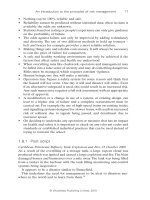How the best leaders lead proven secrets to getting the most out of yourself and others
Bạn đang xem bản rút gọn của tài liệu. Xem và tải ngay bản đầy đủ của tài liệu tại đây (4.24 MB, 257 trang )
How the
Best
Leaders
Lead
This page intentionally left blank
How the
Best
Leaders
Lead
Proven Secrets to Getting the Most
Out of Yourself and Others
Brian Tracy
American Management Association
New York • Atlanta • Brussels • Chicago • Mexico City • San Francisco
Shanghai • Tokyo • Toronto • Washington, D.C.
Special discounts on bulk quantities of AMACOM books are
available to corporations, professional associations, and other
organizations. For details, contact Special Sales Department,
AMACOM, a division of American Management Association,
1601 Broadway, New York, NY 10019.
Tel: 800-250-5308. Fax: 518-891-2372.
E-mail:
Website: www.amacombooks.org/go/specialsales
To view all AMACOM titles go to: www.amacombooks.org
This publication is designed to provide accurate and authoritative
information in regard to the subject matter covered. It is sold with
the understanding that the publisher is not engaged in rendering
legal, accounting, or other professional service. If legal advice or other
expert assistance is required, the services of a competent professional
person should be sought.
Library of Congress Cataloging-in-Publication Data
Tracy, Brian.
How the best leaders lead : proven secrets to getting the most out of yourself
and others / Brian Tracy.
p. cm.
Includes index.
ISBN-13: 978-0-8144-1434-7
ISBN-10: 0-8144-1434-6
1. Leadership. 2. Management. I. Title.
HD57.7.T724 2010
658.4’092—dc22
2009044946
᭧ 2010 Brian Tracy.
All rights reserved.
Printed in the United States of America.
This publication may not be reproduced, stored in a retrieval system, or transmitted in
whole or in part, in any form or by any means, electronic, mechanical, photocopying,
recording, or otherwise, without the prior written permission of AMACOM, a division of
American Management Association, 1601 Broadway, New York, NY 10019
About AMA
American Management Association (www.amanet.org) is a world leader in talent
development, advancing the skills of individuals to drive business success. Our mission
is to support the goals of individuals and organizations through a complete range of
products and services, including classroom and virtual seminars, webcasts, webinars,
podcasts, conferences, corporate and government solutions, business books and
research. AMA’s approach to improving performance combines experiential
learning—learning through doing—with opportunities for ongoing professional growth
at every step of one’s career journey.
Printing number
10
9 8 7 6 5 4 3 2 1
This book is fondly dedicated to Roger Joseph, my friend and
business partner for many years and one of the most competent
and inspirational leaders I have ever met.
This page intentionally left blank
Contents
INTRODUCTION
The Race Is On
1
CHAPTER 1
The Heart of a Leader
11
CHAPTER 2
Leaders Know Themselves
33
CHAPTER 3
Counterattack! Business Lessons from Military Strategy
51
CHAPTER 4
Masterful Management!
83
CHAPTER 5
Hire and Keep the Best People
113
CHAPTER 6
Building Winning Teams
141
CHAPTER 7
Problem Solving and Decision Making
vii
157
CONTENTS
CHAPTER 8
Communicate with Power
177
CHAPTER 9
The Leader’s Questionnaire
193
CHAPTER 10
Simplify Your Life
223
Index
239
viii
I N T R O D U C T I O N
The Race Is On
This page intentionally left blank
‘‘Great hopes make everything possible.’’
— BE NJ AM IN FR AN KL IN
We are living in the most challenging times for business and economics that we have experienced in our lifetimes. Only the fit
will survive. The race is on, and you are in it. If you are not committed to winning, to conquering against all odds, you will be
brushed aside and passed over by people and companies more
determined to win than you are.
Some time ago, Harvard University made three predictions
that apply to the current economic situation. First, they said,
there will be more change in your business in the year ahead
than ever before. Second, there will be more competition in your
business than ever before. And third, there will be more opportunities in your business than ever before.
But these opportunities will be different from the business
that you are accustomed to in the present, and you must move
quickly to take advantage of them if you are going to survive and
thrive against your competitors.
As it happens, these predictions were made in 1952. A fourth
prediction was added later: Those individuals and organizations
3
HOW THE BEST LEADERS LEAD
that do not quickly adapt to the inevitable and unavoidable
changes of today will be in different fields or out of business
within one or two years.
Charles Darwin said, ‘‘Survival goes not necessarily to the
strongest but to the species that is most adaptable to changing
circumstances.’’
Damon Runyon once wrote, ‘‘The race is not necessarily to
the swift, nor the contest to the strong, but that’s the way to bet.’’
You have heard the old saying that the Chinese character for
crisis is the same character used for opportunity. This is because
within almost every crisis there is an opportunity of some kind,
if you can find it.
Brilliant on the Basics
When Vince Lombardi took over the Green Bay Packers, he was
asked if he was going to change the players, the plays, the training, or other key aspects of the team. He replied, ‘‘I’m not going
to change anything; we are simply going to become brilliant on
the basics.’’
The Green Bay Packers had been doing poorly for some years.
In his first meeting with the team, he famously picked up a football and said, ‘‘Gentleman, this is a football.’’
From then on, Lombardi concentrated on the basics, running
drills aimed at making his team faster and more effective at executing plays than any other team. He took the Green Bay Packers
to two Super Bowl Championships and made football coaching
history.
Consistent with the Lombardi method, the key to leading and
succeeding in times of crisis and rapid change is to become ‘‘brilliant on the basics.’’
In this book, based on my work with more than a thousand
companies in fifty-two countries, I will share some of the best
4
INTRODUCTION
thinking and action skills used by top executives and company
owners to achieve outstanding results in difficult markets against
determined competition.
When you practice these ideas and put them into action, you
will get results out of all proportion to your efforts. Sometimes a
single change in direction, inspired by an insight or an idea in
this book, can change your business, and your life, quickly and
dramatically.
The Seven Responsibilities of Leadership
There are seven basics that never change, the key responsibilities
of leadership in any organization. On a scale of 1 to 10, your
ability in each of these seven areas determines your value to
yourself and your contribution to your organization. Here they
are:
Your First Responsibility: Set and Achieve
Business Goals
The number-one reason for business and executive failure is the
inability to achieve the sales, growth, and profitability goals for
which the leader is responsible.
Setting and achieving business goals embraces every part of
strategic and market planning, including products, services, people, productivity, promotion, finances, and competitive responses. We will touch on these critical factors in the pages
ahead.
The Second Responsibility of Leadership: Innovate
and Market
As Peter Drucker said, the purpose of a business is to ‘‘create and
keep a customer.’’
5
HOW THE BEST LEADERS LEAD
Only through continuous innovation of products, services,
processes, and promotional methods can companies create and
keep customers. As Bruce Henderson of the Boston Consulting
Group wrote, ‘‘All strategic planning is market planning.’’
The Third Responsibility of Leadership: Solve
Problems and Make Decisions
This is so important that I will dedicate an entire chapter to the
problem solving and decision making skills that you absolutely
must master to be an effective leader. Remember, a goal unachieved is merely a problem unsolved. A sales target unachieved
is a problem unsolved. The only obstacles that stand between
you and the business success you desire are problems, difficulties, hindrances, and barriers. Your ability to go over, under, or
around these problems is central to your success.
The Fourth Responsibility of Leadership: Set
Priorities and Focus on Key Tasks
One of the most important jobs you do is to deploy limited resources, especially of people and money, into those areas where
they can make the greatest contribution to the success of the
enterprise.
The law of the excluded alternative says, ‘‘Doing one thing
means not doing something else.’’
Time is your scarcest resource. It is limited, perishable, irretrievable, and irreplaceable. The way you allocate your time can
be the critical determinant of everything you achieve—or fail to
achieve.
The Fifth Responsibility of Leadership: Be a Role
Model to Others
Albert Schweitzer once wrote, ‘‘You must teach men at the school
of example, for they will learn at no other.’’
6
INTRODUCTION
Throughout the ages, the example that you establish in your
character, attitude, personality, and work habits, and especially
the way you treat other people, sets the tone for your department
or organization.
You do not raise morale in an organization; it always filters
down from the top. There are no bad soldiers under a good general.
One of the great questions for you to continually ask yourself
is, ‘‘What kind of a company would my company be if everyone
in it was just like me?’’
Marshall Goldsmith, top executive coach for senior executives in the Fortune 1000, has demonstrated over the years that a
single change in a behavioral characteristic of a key executive can
cause a positive multiplier effect that impacts the behavior of an
enormous number of people.
Leaders conduct themselves as though everyone is watching,
even when no one is watching.
The Sixth Responsibility of Leadership: Persuade,
Inspire, and Motivate Others to Follow You
Tom Peters said that the best leaders don’t create followers, they
create leaders. It’s true that you want your people to have initiative and the liberty to act on that initiative. But all initiatives must
be in the support and service of what you are trying to achieve as
a leader.
If people aren’t following you, you are not a leader. If no one
is listening to you, believes you, or cares what you say, you are
not going to succeed. If people are only going through the motions to earn a paycheck, the greatest business strategy in the
world will fail.
You must motivate others to follow your vision, to support
and achieve the goals and objectives that you have set, to buy
into the mission of the organization as you see it. Today, getting
7
HOW THE BEST LEADERS LEAD
others to follow you takes more than command and control. You
have to earn their trust, respect, and confidence. That is the key
to sustainable success as a leader.
The Seventh Responsibility of Leadership: Perform
and Get Results
In the final analysis, your ability to get the results that are expected of you is the critical factor that determines your success.
In the pages ahead, I will show you a series of simple, proven,
practical methods and techniques used by top executives and
business owners everywhere to get better, faster, and more predictable results in any business or organization or in any economic situation.
Each Crisis Contains an Opportunity
‘‘Professional soldiers pray for peace, but hope for war.’’
What does this saying mean? It means that soldiers pray for
peace because war is so terrible: Every sensible person wants to
live out their life in peace and for as long as possible, including
soldiers.
But only during warfare, during critical moments on the battlefield, is it possible to achieve distinction and be rapidly promoted. Professional soldiers hope for war, in the back of their
minds, so they can demonstrate their fitness and capability for
higher command.
Viktor Frankl, a survivor of Auschwitz during World War II
and the founder of Logotherapy, famously wrote, ‘‘The last great
freedom is the freedom to choose your own mental attitude
under any set of conditions.’’
A senior executive friend of mine, whose company had suffered sales declines of 40 percent in less than a year and was
8
INTRODUCTION
reeling from the reversals in the economy, told me how he maintained a positive attitude every day.
He said, ‘‘Each morning, when I get up, I have a decision to
make. I can be happy, or I can be very happy. I therefore decide
that today, I will be very happy, and I allow that attitude to guide
me throughout the day, no matter what happens.’’
You too can choose your own attitude under any given set of
circumstances. You can decide to be positive, constructive, and
forward-looking. You can look upon each ‘‘crisis’’ as an ‘‘opportunity,’’ even if it is only an opportunity for you to grow, mature,
become stronger, and perhaps even achieve the kind of ‘‘battlefield promotions’’ that will stay with you for the rest of your career.
Welcome to the twenty-first century!
9
This page intentionally left blank
1
C H A P T E R
O N E
The Heart of
a Leader
This page intentionally left blank
‘‘Character may be manifested in the great
moments, but it is made in the small ones.’’
— WI NS TO N C HU RC HI LL
Leadership is the single most important factor in the success or
failure of a company or business. Your ability to step forward and
lead your enterprise to success in competitive markets is both
essential and irreplaceable.
The better you become as a leader, the better you will be in
every area of your enterprise. Fortunately, leaders are made, not
born. As Peter Drucker wrote, ‘‘There may be such a thing as a
natural born leader, but there are so few of them, that they make
no difference in the great scheme of things.’’
Leaders are primarily self-made, self-developed. They work
on themselves continually, learning, growing, and becoming
more capable and competent over the years.
Leaders usually emerge to deal with a situation that requires
leadership skills. A manager can work successfully at fulfilling his
responsibilities and getting the job done for many years. Then a
13
HOW THE BEST LEADERS LEAD
crisis occurs, and leadership is required. At that time, the leader
steps forth and takes charge of the situation. He or she becomes
a different person and fulfills a different role.
Follow the Rules
General Norman Schwarzkopf tells about his first experience of
leadership at the Pentagon. His senior officer told him that to do
his job well, all he had to do was to ‘‘Follow rule 13.’’
When he asked, ‘‘What is rule 13?’’ his commanding general
said, ‘‘When placed in command, take charge!’’
When then Colonel Schwarzkopf asked, ‘‘But after I have
taken charge, how do I make decisions?’’
His commanding officer said, ‘‘Simple. Use rule 14.’’
When Colonel Schwarzkopf asked, ‘‘What is rule 14?’’ he was
told, ‘‘Do the right thing!’’
These are excellent ideas for you, as well. When placed in
command, take charge, and if ever you are in doubt about what
to do, simply do the right thing.
Leadership Requires Character
Leadership is more about who you are than what you do. Your
ability to develop the qualities of effective leadership, the essence
of what it takes to be a leader, is more important to your success
as an executive than any other factor.
One of the great principles of personal development is,
‘‘Whatever you dwell upon grows and expands in your experience and personality.’’
You become more effective, day by day, when you think and
act on the basis of the key qualities of effective leaders throughout the ages. You program these qualities into your personality
14
THE HEART OF A LEADER
and behavior by dwelling on them continually. You learn these
qualities by practicing them in your daily activities as a person
and as a leader in your organization.
The more of a leader you become in the inside, the more effective you will become in all your leadership activities on the
outside. You become more of a leader by thinking the same way
that top leaders think.
The Seven Qualities of Leadership
There have been more than three thousand studies conducted
over the years aimed at identifying the qualities of successful
leaders, especially successful military leaders who have won important battles against great odds in turbulent theaters of warfare—which very much describes succeeding in the marketplaces
of today.
More than 50 qualities have been identified that are important to leadership. But there are seven qualities that seem to
stand out as being more important than the others. The good
news is that each of these qualities can be learned, and they must
be learned by practice and repetition.
1. Vision: The Most Important Single Quality
of Leadership
Leaders have vision. They can see into the future. They have a
clear, exciting idea of where they are going and what they are
trying to accomplish. This quality separates them from managers. Having a clear vision turns the individual into a special type
of person.
This quality of vision changes a ‘‘transactional manager’’ into
a ‘‘transformational leader.’’ While a manager gets the job done,
a true leader taps into the emotions of his people.
15
HOW THE BEST LEADERS LEAD
In times of rapid change and turbulence, it’s a good idea to
occasionally call a ‘‘time out.’’ Stop the clock. Back off. Take
some time to think about who you really are inside, what you
stand for, where you are going, and what kind of a future you
want to create for yourself and your organization.
In their book, Competing for the Future, Gary Hamel and V.K.
Prahalad emphasize the key role of ‘‘future intent’’ to business
success. They explain that the greater clarity you have with regard to the future you wish to create, the easier it is for you to
make the day-to-day decisions necessary to reach that future.
As a leader, in order to remain calm and centered in times of
rapid change, you must continually ask two questions: ‘‘What are
we trying to do?’’ and ‘‘How are we trying to do it?’’
You must play your own game rather than allow yourself to
be knocked off center by unexpected setbacks and difficulties.
You achieve this by developing a clear vision for yourself and
your organization and then by sharing this vision of an ideal future with the people who look up to you and depend upon you
for leadership.
Developing Your Vision
Begin with your values. What are the organizing principles of
your business that you believe in and stand for? What are the
core values and beliefs that animate and motivate you? What are
the values that your company practices and incorporates into all
of its activities?
The difference between leaders and average people is that
leaders have clear beliefs that they will not compromise under
any circumstances. Average people have fuzzy or unclear values
that they will compromise for short-term advantage.
Based on your values, imagine the perfect future for your
business.
16









